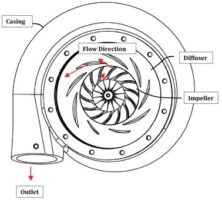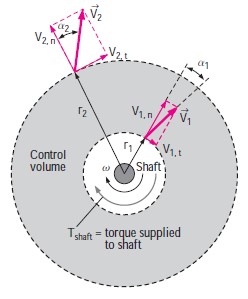centrifugal compressor
The compressor has the function of compressing/compressing the gas fluid into a small volume so that the temperature and pressure of the gas fluid increases. In other words, the compressor receives a mass flow of gas with a low temperature and pressure and then raises the temperature and pressure of the gas mass.
Centrifugal compressor is one of the mechanical equipment that goes into the type of rotating mechanical equipment. In general, mechanical equipment itself is divided into two types: static equipment and rotating equipment. Basically, the compressor has moving components. The use of compressors is very easy for us to encounter both in the industrial world and in our daily lives, but we do not realize it. Starting from compressors to fill air into tires, compressors in refrigeration, machinery, chemical processes, gas transmission, manufacturing and in almost every place where there is a need to compress compressible fluids.
The working principle of a centrifugal compressor is almost the same as a centrifugal pump. This compressor utilizes centrifugal force to increase the pressure and flow of fluid from the inlet to the outlet.

The rotation of the compressor impeller can produce a moment of force (torque) to the incoming liquid so that it creates a centrifugal force towards the outlet. Moment of force is an external force that causes an object to move in a circle around its axis of rotation.
In the case of a centrifugal compressor, the moment of force is the product of the cross product between the radius of the impeller and the change in the angular momentum of the impeller. Since the change in the angular momentum of the impeller is perpendicular to the radius, the direction of the moment of force will be toward the impeller (90 degrees). Keep in mind that centrifugal compressors have two impellers that rotate together at the inlet and outlet. So the total moment of the compressor force is the reduction of the moment of the outlet force with the inlet.

The total moment of force (torque) in the centrifugal compressor is formulated by Euler in the Euler’s turbine formula as:
T shaft = [r2.(m2.V2)]-[r1.(m1.V1)], because the fluid used at the outlet and inlet is the same,
m1 = m2 = m. then…
T shaft = m.[(r2.V2) – (r2.V2)]
where,
T = Total torque (Nm)
m = Mass flow rate of fluid (kg/s)
r1,r2 = inlet and outlet impeller radius (m)
V1,V2 = Linear velocity that perpendicular to the inlet and outlet impeller (m/s)
However, the calculation of centrifugal compressor analysis in the field is not that simple. The complexity of the emerging forces is very complicated if modeled into a mathematical formula. The method commonly used to analyze the flow of compressor forces is the CFD method. CFD is a method of simulating fluid flow in the design using a computer.
>> CLICK HERE TO LEARN ABOUT COMPRESSOR CENTRIFUGAL SIMULATION USING CFD METHOD !
Contributor: Daris Arsyada

aeroengineering services is a service under CV. Markom with solutions especially CFD/FEA.
References:
Cengel, Yunus A dan John M Cimbala. 2006. Fluid Mechanics: Fundamental and Application. New York: The McGraw-Hill Companies, Inc.
https://www.aiche.org/sites/default/files/cep/20130644.pdf (accessed on April 5, 2021)
https://www.airbestpractices.com/technology/air-compressors/centrifugal-air-compressor-controls-and-sizing-basics (accessed on April 5, 2021)




Leave a Reply
Want to join the discussion?Feel free to contribute!